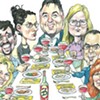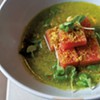Published September 4, 2013 at 10:24 a.m.
Ronald Pal isn’t a trophy hunter. The New York City native said that in the 42 years he’s lived in Sutton, he’s piled up enough deer antlers to crowd his house — and made good use of the venison. “I’d just as soon shoot a year-old deer when the meat is tender,” he reasoned.
Now Pal is about to start hunting and eating a different beast. “A young bear, 2 years old, would be just ideal. I look for good cuisine,” he said, planning his next quarry.
He’s not alone. Pal was one of more than 50 hunters who attended “Getting Started in Bear Hunting,” a free seminar organized by the Vermont Fish & Wildlife Department in St. Johnsbury last month. Students drove to the class from as far as Connecticut and New York’s Hudson Valley to learn bear-hunting basics and enjoy an ursine-focused barbecue lunch.
“It’ll be a man’s lunch, ’cause it’ll be meat!” growled John Pellegrini, as the last camo-clad students wedged themselves into the kind of desk-chairs many of us hadn’t sat in since elementary school. The seminar took place in the taxidermy-filled garage of Linwood Smith Archery. Gray-haired owner Smith stood near the door dressed in an outfit that accommodated serious-looking knives, as if he were ready to defend the class of hunters single-handedly from threatening intruders.
Pellegrini organized the event in his role as Fish & Wildlife’s hunter-training coordinator. The 20-person turnout for a similar class held last year in southern Vermont didn’t prepare him for the popularity of this one, he said.
Bear hunting is on the rise, partly owing to Fish & Wildlife’s push to control a population that stands at about 6000 statewide. That’s in the uppermost reaches of the population goals outlined in the Vermont Big Game Management Plan, which covers the years 2010 to 2020.
When the ursine population soars, so do encounters with “nuisance bears.” Remember the four fuzzy forest dwellers eating out of Gov. Peter Shumlin’s bird feeder last year? Bears tempted into backyards by garbage, pet food or uncleaned grills top Fish & Wildlife’s hit list.
Hunters are key to curbing that growth. Many are drawn to bear hunting by the thrill of the chase and the promise of capturing a trophy that can dominate a living room, but others, like Pal, are in it for the gustatory delights.
Pellegrini was lucky enough to have samples to offer. Two nuisance bears had been killed in the Ascutney area in the week before the class. One furnished the barbecue lunch, while the other was the star attraction in a presentation on trophy preparation by Northfield taxidermists Theresa and Rodney Elmer.
In the first slideshow presentation of the morning, bear biologist Forrest Hammond demonstrated the dangers of treating nuisance bears like pets. One image showed an older man who made a lifelong habit of feeding the creatures. Claw marks covered his back, and his right arm was still slightly askew from reattachment. A bear had attacked him after he ran out of marshmallows to pop in its mouth.
The last recorded Vermont instance of a bear killing a human happened in West Townshend in 1943. The victim was known for shooting deer to incapacitate them before finishing them off with a knife; he was found in the bloody snow with his ribs crushed. “We don’t have bears intentionally hunting down people,” Hammond concluded.
Hammond is more scientist than hunter, and after showing multiple photos of bear poop, he joked that his title should actually be state “bear scatologist.”
But in his line of work, and for hunters, poo is important. Droppings let hunters know not only that a bear has been in the area but what it’s been eating, potentially leading them to the food source — and to some meat of their own.
Cutesy Adirondack wood carvings are accurate: Black bears love berries. Beechnuts, apples and corn are also among their favorite treats in season. In the second presentation, hunter and Colchester police sergeant James Roy said he’s planted clover — bear chocolate — all over his Northeast Kingdom camp to attract the critters.
Proximity to other food sources can dictate the location of a good hunt. For hunters, cornfields present an ideal situation, Roy said. Bears are crazy for the milky corn still available as the hunting season starts on September 1, and farmers want to save their crops. Roy showed slides of the damage bears can do to cornfields — overhead shots recalling crop circles — and suggested hunters offer their services to corn or apple farmers.
Roy has plenty of his own experience. In a secret Northeast Kingdom location, he said, “within seven years, we’ve killed seven bears in a 150-yard circle. Excellent cover, excellent terrain.”
And excellent technology. Roy tracks his targets for weeks before bear season begins, using trail cameras to watch bear behavior from home. He showed a video of a baby bear holding itself up on two legs, and the classroom erupted as if it were watching “American’s Funniest Home Videos.”
There are no laws against targeting the little ones, but most hunters said they’d be ethically opposed to shooting a very young bear or firing into a den. Accordingly, Roy helped educate the class on what a bear looks like at different stages of life. A head like a German shepherd and gangly legs? Keep moving. Ears like Oreos and no visible legs beneath a hefty body? Dinner.
Roy said a skinned bear doesn’t look too different from human corpses he’s seen in the autopsy room in his cop job, but that doesn’t stop him from enjoying the well-marbled meat. “I’m a meat eater. I love bear meat,” he said. “You take care of them the right way — get ’em in the freezer and cook ’em the right way — and it’s some of the tastiest meat you’ll ever have in your life.”
As Roy finished his presentation, smells of caramelizing fat wafted into the garage. Pellegrini’s crew had prepared a feast for lunch. And it was meaty, indeed. The only offerings resembling vegetables were potato chips, relish and ketchup.
But nutrition wasn’t the point. Though six ounces of bear meat has only 276 calories (compared to 318 in the same quantity of London broil), hunters prize it mainly for its flavor.
“I think there’s a lot of misconceptions about bear meat. You hear the same thing: ‘Oh, it’s really greasy,’” Pellegrini later told me. “If you trim the fat off, you don’t have to deal with the tallow or greasy taste. We cooked some steaks over an open fire the other day. It was delicious.”
I became a fan of bear meat at local game suppers. When braised, the ultra-creamy flesh melts like wagyu brisket. The barbecue menu included bear burgers and sweet and hot Italian sausages prepared by Pellegrini’s favorite butcher in Orange.
Unless someone starts farming black bear, don’t plan on having a rare steak. Because of the likelihood of parasites, the meat must be cooked through. But good marbling ensures that even when the meat is charred on the outside, the inside is far from dry. The flavor is startlingly similar to that of beef.
After lunch, the hunters gathered around an outdoor table as the Elmers set to skinning their young female nuisance bear. First, they extracted the first premolar tooth from her upper jaw. For data-gathering purposes, Fish & Wildlife will soon require that all successful bear hunters send in these teeth.
Using a relatively dull knife, Rodney Elmer was done in seconds. As the couple removed the bear’s skin, they recommended quickly freezing an animal if the hunter plans both to eat and stuff it. Hanging it for aging purposes is ideal for tender meat, but the skin could degrade in that time, making taxidermy impossible.
Rodney Elmer pointed out the meat along the muscular cheeks of the bear’s ever-growing skull as his favorite. “I just don’t like picking hair out of my food — that’s my thing,” Theresa Elmer joked.
“Any meat — especially slice it thin, slice it cross-grain, and put it in a pan with butter and onions and beer with a little Montréal seasoning — is beautiful,” added her husband.
Every hunter seems to have a recipe to share, and Hammond has compiled a list that he handed out to attendees.
Pal has his own plans. He has a butcher on call to deal with the bear’s musculature, but said his wife is especially fond of cooking the offal. The couple already imagines pairing the bear’s liver — which Pal has never tasted — with vegetables they’re preserving from their harvest, perhaps a side of Hungarian-style creamed zucchini with dill.
Rodney Elmer hopes such tasty prospects will encourage Vermonters to eat more wild game. “It is the greenest meat there is,” he said of eating to reduce the bear population. “Small people can make big changes.”
Locavore chefs, take note.
The original print version of this article was headlined "Ursine Cuisine."
More By This Author
Comments
Comments are closed.
From 2014-2020, Seven Days allowed readers to comment on all stories posted on our website. While we've appreciated the suggestions and insights, right now Seven Days is prioritizing our core mission — producing high-quality, responsible local journalism — over moderating online debates between readers.
To criticize, correct or praise our reporting, please send us a letter to the editor or send us a tip. We’ll check it out and report the results.
Online comments may return when we have better tech tools for managing them. Thanks for reading.















































